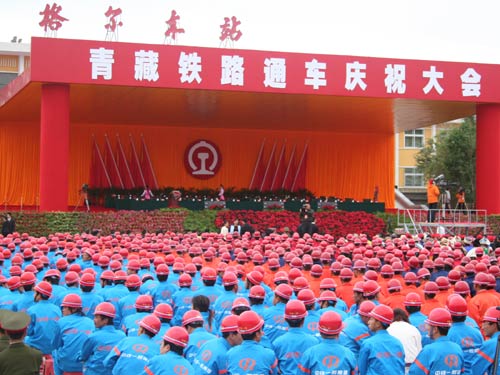Top News
Qinghai-Tibet rail rumbles across 'roof of the world'
(Xinhua)
Updated: 2006-07-01 13:46
 |
Large Medium Small |
Slideshows on Tibet's first railway
Slideshows on Tibet
China on Saturday opened the world's most elevated railway with the first pair of passenger trains traveling across the "roof of the world."
 Photo taken on July 1, 2006 shows the venue of the launching ceremony of the Qinghai-Tibet Railway in Golmud, a start-off point of the landmark railway in northwest China's Qinghai Province. [Xinhua] |
Two trains set off at Golmud and Lhasa, the two start-up points of the Qinghai-Tibet Railway that is dubbed an "engineering marvel " that has linked Tibet with the rest of China for the first time.
A passenger train coded "Qing 1" pulled out from the Golmud station at 11:05 a.m., carrying about 600 passengers including role models of builders of the railway, representatives from the Chinese government, journalists from official media organizations including Xinhua News Agency and CCTV, in addition to ordinary passengers who bought their own tickets.
Plates inscribed with the words of "Eight Honors and Eight Disgraces", standards set by President Hu Jintao to boost socialist morality, were hung in the cars of the train, which is scheduled to arrive in Lhasa at midnight.
Before the train left, Hu made a keynote speech at a launching ceremony of the railway, and cut the red ribbon for the opening of the railway.
The opening to traffic of the Qinghai-Tibet Railway, Hu said, is another magnificent accomplishment we have achieved in our socialist modernization drive. Construction of the Qinghai-Tibet railroad is a long-cherished dream of generations of the Chinese people.
"The project is not only a magnificent feat in China's history of railway construction, but is also a great miracle of the world' s railroad history," he told an audience of 2,600 on a square in front of the Golmud railway station.
Some 1,142 kilometers away, Tibet's regional capital Lhasa saw off a train bound for Lanzhou, capital of northwest China's Gansu Province, at 11:12 a.m.. The train, coded "Tibet 2", carries about 700 passengers in 16 compartments and is expected to arrive in Lanzhou in 30 hours.
Norbu, a 28-year-old Tibetan farmer from Gonggar, left home before daybreak to join the celebrations at Lhasa railway station and to catch a glimpse of the train. "I'll board a train myself sometime to visit the inland areas."
Xie Yuke from Qinghai provincial railway administration, 35, a Han Chinese, is piloting the train's maiden trip on the plateau. Among the passengers are Tibetan herdsmen, farmers, retired governmental officials, builders of the railway and journalists.
Trains traveling across the roof of the world, with extra oxygen pumped into the cabins to prevent passengers from suffering altitude sickness, will traverse a mountain pass sitting 5,072 meters above sea level as it rises up to the Tibetan plateau, and will drive through the Hoh Xil, China's largest area of uninhabited land.
The cars were installed with environment-friendly toilets, wastewater deposit tank and garbage treatment facilities to protect environment along the railroad.
All the Chinese characters that appear on the electronic screen in each railway car have been translated into Tibetan and English.
The Qinghai-Tibet railway is 1,956 kilometers long, with 960 km of the track located 4,000 meters above the sea level and the highest point at 5,072 meters. The project is dubbed an " engineering marvel" because people used to think the perennial ice and slush along the route could never support tracks and trains.
The railway is projected to help double tourism revenues by 2010 and reduce transport costs for goods by 75 percent in Tibet, officials said.
Backgrounder: Key facts about Qinghai-Tibet Railway
China will open the world's most elevated railroad, the Qinghai-Tibet Railway, on Saturday. Below are some facts about the Qinghai-Tibet Railway:
-- Qinghai-Tibet Railway is the first railroad linking Tibet with the rest of China.
-- China has solved three major difficulties, namely frozen tundra, high altitude and plateau environmental protection, to rewrite the world's history of railway construction with the completion of Qinghai-Tibet Railway.
-- None of the hundreds of thousands of railway builders died of altitude sickness in the past five years.
-- Qinghai-Tibet Railway is the world's highest railway. Some 960 kilometers of its tracks are located 4,000 meters above sea level and the highest point is 5,072 meters, at least 200 meters higher than the Peruvian railway in the Andes, which was formerly the world's most elevated rail.
-- The railway is the world's longest plateau railroad, extending 1,956 kilometers from Qinghai's provincial capital Xining to Lhasa in Tibet. The newly completed Golmud-Lhasa section zigzags 1,142 kilometers across the Kunlun and Tanggula mountain ranges.
-- About 550 kilometers of the tracks run on frozen earth, the longest in any of the world's plateau railways.
-- Tanggula Railway Station, 5,068 meters above sea level, is the highest railway station in the world.
-- Fenghuoshan Tunnel, 4,905 meters above sea level, is the world's most elevated tunnel on frozen earth.
-- Kunlun Mountain Tunnel, running 1,686 meters, is the world's longest plateau tunnel built on frozen earth.
-- Upon its completion, the maximum train speed is designed to reach 100 kilometers per hour in the frozen earth areas and 120 kilometers per hour on non-frozen earth.
-- Construction of the Golmud-Lhasa section of the landmark railway commenced on June 29, 2001.
-- About 29.46 billion yuan (3.68 billion U.S. dollars) had been spent on the Golmud-Lhasa section which runs 1,142 kilometers.
-- The basic coach ticket, called a hard seat, sells for 389 yuan (48.6 U.S. dollars) from Beijing to Lhasa, while the price for hard sleeper or bunk costs 813 yuan (101.6 dollars), and the price for a shared compartment or soft sleeper is 1,262 yuan (157. 75 dollars).